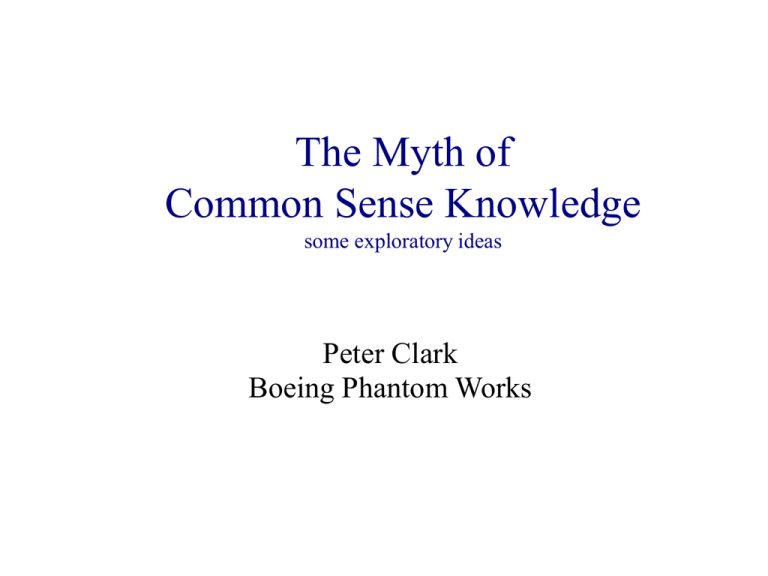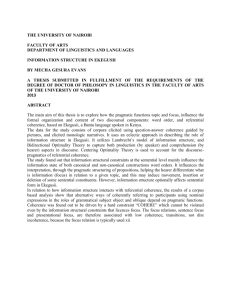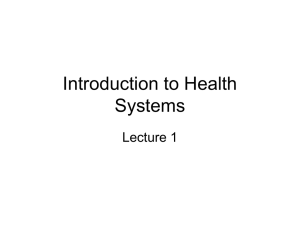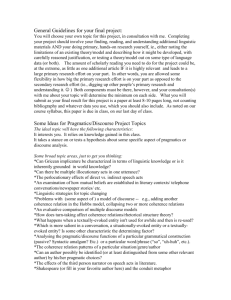The Myth of Commonsense Knowledge
advertisement

The Myth of Common Sense Knowledge some exploratory ideas Peter Clark Boeing Phantom Works The Myth of Common-Sense: All you need is knowledge… “We don’t believe that there’s any shortcut to being intelligent; the “secret” is to have lots of knowledge.” Lenat & Guha ‘86 “Knowledge is the primary source of the intellectual power of intelligent agents, both human and computer.” Feigenbaum ‘96 “Lenat and Feigenbaum suggest that just a million frames, massaged by already-understood control structures, coupld intelligently manifest the sum total of human knowledge.” Smith ‘91 The Myth of Common-Sense • Common, implicit assumption (belief?) in AI: – Knowledge is the key to intelligence – Acquisition of knowledge is bottleneck • Spawned from: – ’70s experience with Expert Systems • Feigenbaum’s “knowledge acquisition bottleneck” – Introspection • The assumption has fueled many programs… A Rallying Cry…. “…What ontological categories would make up an adequate set for carving up the universe? How are they related? What are the important things most humans today know about solid objects? And so on. In short, we must bite the bullet.” Lenat & Guha ‘86 Manifested in Multiple Programs: Manual Knowledge-Base Construction • Cyc • Botany KB (Porter et al, 85-95) • DARPA – High Performance Knowledge Base (HPKB) – Rapid Knowledge Formation (RKF) • ThoughtTreasure • Language-based knowledge resources – WordNet – Pangloss – MicroKosmos • And, of course, our own smallish endeavor here Manifested in Multiple Programs: Automated Knowledge-Base Construction • Advances in NLP and statistical corpus-based technologies have raised hopes of building KBs automatically – Far from abandoning the quest for knowledge, researchers see new opportunities for acquiring it – Recent boost from intelligence community Manifested in Multiple Programs: Automated Knowledge-Base Construction • Dictionary Mining – MindNet (Microsoft) – Extended WordNet (HLI, Dallas) • Corpus-based processing – Schubert (Rochester); also us here! – Girju (UT Dallas) – Ontology learning technologies – Hovy (ISI) • convert the entire Web into a knowledge base These techniques are rapidly overtaking the manual methods (for certain types of knowledge)… Manifested in Multiple Programs: Community-Based Construction • OpenMind – community-based entry of knowledge • The Semantic Web – “knowledge processable by machines” • semantic markup and annotation – vision of a (very) large distributed KB In fact… • it’s not so difficult to build a large KB these days… • …so where are the intelligent machines? What Happens when you have lots of knowledge? (income GeorgeBush X)? -> (residesIn GeorgeBush Shack)? -> owns shack? -> spouse resides in shack? -> spouse? -> person married on wedding day? -> wedding day? -> date on marriage certificate? -> … What Happens when you have lots of knowledge? Tweety is a penguin. (residesInRegion Tweety X)? -> is Tweety a citizen of city X? -> is Tweety the head of state of X? -> is Tweety the monarch of X? -> … What Happens when you have lots of knowledge? (maritalStatus BillClinton X) -> age(BillClinton,A), A < 18? [-> single] -> age of BillClinton? -> does he have a twin? -> is he a baby? -> …. What Happens when you have lots of knowledge? (volume USS-Enterprise X) -> Is USS-Enterprise a human adult? -> Isa Galaxy? Pebble? Boulder? Shampoo? Soup? … “A man drives a car to the airport”… What Happens when you have lots of knowledge? Far from expert systems “failing” due to their myopic knowledge of the world, this is a primary reason for their success. Problems that the AI Community have not taken Seriously Enough • • • • Reasoning with “messy” knowledge – Errors – Approximations – Different unstated assumptions Facts may conflict in certain circumstances Incompatible with the backward-chaining, deductive paradigm Spawns into problems/topics of: 1. Elaboration 2. Coherence 3. Encoding possibilities 4. Relevance/viewpoints/Context Reasoning with Messy Knowledge • Not about deductive backward chaining… • Rather is about creating coherent models “Messy” background knowledge Elaboration Coherence Possibilities Relevance/ Context ? ? Fragmented and ambiguous input Coherent Model (situation-specific) 1. Elaboration • Answering questions with messy knowledge – not enough to backward chain – need to create a coherent model • need to elaborate possible components of the model Age of Bush? Resides in a shack? President Spouse resides in a shack? Resides in WhiteHouse Spouse? 1. Elaboration: LTI’s Illustration “The kid hit the ball hard.” 1. Elaboration: Thought experiment “Joe chopped down the tree.” • A vivid picture comes to mind – John: adult male, out in woods – holding an axe (or chain saw?) – Tree is ~30ft high pine tree • or: a modification of that time I sawed a Christmas tree • or: that documentary on logging in Canada • • • • 8:1 ratio of prior to explicit knowledge (Graesser, ’81) Episodic/experiential knowledge plays a key role Also core knowledge plays a key role Not a deductive process! 2. Coherence: What Makes a Representation (Model) Coherent? • We don’t just blindly accept new knowledge: – Minsky: We proactively ask a set of pertinent questions about a scene, e.g., what is X for? What are the goals? etc. • What makes a representation coherent? – Simple consistency (“The man fired the gnu.”) – Purposefulness (for artifacts): • “The engine contains a thrust reverser.” • vs. “The engine contains an elephant.” • vs. “The engine contains a book.” • “Knowledge entry” is a serious misnomer! – Really talking about Knowledge Integration 2. Coherence: A Catalog of Coherence Criterea 1. Volitional actions: – Agents must be capable of an action • legally, skill, fiscally, anatomically – Action serves a broader purpose/goal – Need equipment/resources/instruments, instruments must be adequate 2. Non-volitional actions; – There is a cause (inc. randomness) – Spatial: • statics: objects must be close • dynamics: objects can move in the required way – Temporal: objects exist at the same time 2. Coherence: A Catalog of Coherence Criterea (cont) 3. Objects: – physically possible • • • parts connected together at appropriate places materials are appropriate suspension/tension etc., gravity – physically normal/expected/standard • 4. need to know normal shapes, sizes, etc. Artifacts: – Purposefulness: • all parts play some role wrt. one of its intended functions (or subtasks thereof). Expect design to be optimized. – Could treat biological objects as “artifacts” 2. Coherence and Reasoning Engines • Inference engines unable to tolerate incoherence: – Current: “Error! Switching on the debugger…” – Desired: “This representation is generally ok, except this bit looks weird, and that bit conflicts with this bit.” • Problem compounded by long inference chains • How could we change a reasoner to be more tolerant? 3. Representing Possibilities • Represent things which “might” happen – Not quite probabilities – More, sanctioning certain facts • Use this to guide search for coherence People can walk People can eat food A person can be happy A person can go to a shop … Semantics? Like a third truth value? 3. Automatically acquired possibilities… Based on Schubert-style corpus analysis: … Banks may agree. Banks may have borrowings. Banks may seek approvals. Banks may estimate shortfalls. … Bonds may be guaranteed. Bonds may be listed. Bonds may see gains. … Commissions may approve changes. … Companies may elect directors. Companies may blame weather. Companies may own shares. … Elections may be scheduled. Elections can be annual. Exports may rise. … Figures can be preliminary. Figures may be revealed. Figures may be stated. Figures may exclude losses. … Shareholders may receive shares. Shareholders may vote. … Shares may climb. Shares may trade. … Spokesmen may decline comments. … Workers can be salaried. … 4. Viewpoints and Context • Far from expert systems “failing” due to their myopic knowledge of the world, this is a primary reason for their success. • Can we model this? – Contexts – Selection of reasoning components/modules? 4. Viewpoints and Context vs. Reason over Giant KB Component theories/ ontologies(?) Problem-specific KB, contains selected units • Latter seems right, but: – can a big KB really be partitioned like this? (everything is connected!) • Models may vary by: – ignoring detail – making different approximations – using different ontologies 4. Viewpoints and Context • e.g., DNA = sequence of different region types: – intron-exon-intron-exon… – promotor-gene-terminator – nucleotide pair-nuc pair-nuc pair… • Makes a difference: – Given: “The polymerase attaches to the promotor, and then moves down the strand.” – then answer: “Where will the polymerase be?” • nucleotide? gene? intron? • The point: It’s not simply a matter of having all viewpoints coexisting • Another example: “A satellite sends signals/messages/position information.” Summary • The myth of common-sense: – Knowledge is the key to intelligence • The truth: – Knowledge is only part of the equation • and less and less the most significant part – Rather, radical revisions to reasoning are needed • Messy knowledge is here to stay • Old reasoning paradigms do not work effectively with this • Need some new approaches, touching issues of elaboration, coherence, possibilities, viewpoints





